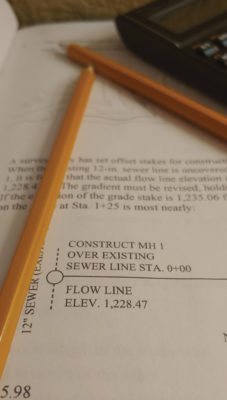 Different states license surveyors to provide different services relevant to each respective jurisdiction. Our common function in every state is focused on boundary surveying. Where some states include photogrammetry within the practice of surveying others license it as a unique discipline. Roughly a third of the states include some detailed practice with grading and drainage. Of course, there’s the colonial states, along with Kentucky, Tennessee, and Texas that are not part of the USPLSS, followed by Ohio which encompasses the USPLSS, colonial lands, and the Western Reserve among its nine major land systems. Some USPLSS states are regulated under Tiffin’s instructions, and others are bound to a particular edition of The Manual of Surveying Instructions for Public Lands. Most of us in USPLSS states are retracing under state law but the Alaskan surveyors are glued to the federal directions under the latest manuals. Suffice to say professional land surveying has its nuisances.
Different states license surveyors to provide different services relevant to each respective jurisdiction. Our common function in every state is focused on boundary surveying. Where some states include photogrammetry within the practice of surveying others license it as a unique discipline. Roughly a third of the states include some detailed practice with grading and drainage. Of course, there’s the colonial states, along with Kentucky, Tennessee, and Texas that are not part of the USPLSS, followed by Ohio which encompasses the USPLSS, colonial lands, and the Western Reserve among its nine major land systems. Some USPLSS states are regulated under Tiffin’s instructions, and others are bound to a particular edition of The Manual of Surveying Instructions for Public Lands. Most of us in USPLSS states are retracing under state law but the Alaskan surveyors are glued to the federal directions under the latest manuals. Suffice to say professional land surveying has its nuisances.
The state boards cooperate through the NCEES to establish a benchmark of minimum competence via the Fundamentals of Surveying and Principles & Practices test battery. The NCEES delivers rigorous psychometrics defining that benchmark consistent with a broad and collective definition of practice. The member boards are legislatively empowered by their state to ensure the benchmark represents their local standards. Each member board under its own law further administers a unique state test. Currently state tests range from intense all-day affairs to simple mail home tests.
The profession itself is organically evolving to a point where the metrics of competence are being redefined. For example, we have seen mapping standards addressed on a national platform. The fact is that mountains, rivers, watersheds, highways, railroads and natural disasters exceed state boundaries. The scientific practice of mapping itself translates extremely well across jurisdictional boundaries ergo a common level of competence can be readily packaged for every jurisdiction. Conversely, roughly one third of the states empower surveyors to provide grading and drainage services. This presents a psychometric imbalance in states where the practices are irrelevant or perhaps even illegal within a local definition of surveying. Then we have the artful debate over colonial vs. USPLSS content. The relevant issue to the state courts is a fundamental understanding of the difference between retracement and original survey methods. Very few of us perform original USPLSS surveys under the current manual however the Alaskans are working “in the manual” and are a clear front runner for that type of content in a test. For most of us the manual is a reference for retracing competitive land grants governed under common law. Move four time zones toward Greenwich and the understanding of USPLSS content in the colonial states becomes mostly irrelevant.
 Recently the member boards of NCEES requested and voted to authorize the formation of a land surveying test module task force. The charge was a feasibility analysis offering specific test content modules. The results of the analysis suggested a core test coupled with a combination of modules intending to replicate the current national standard along with targeting specific jurisdictional content. Not a bad concept from my perch.
Recently the member boards of NCEES requested and voted to authorize the formation of a land surveying test module task force. The charge was a feasibility analysis offering specific test content modules. The results of the analysis suggested a core test coupled with a combination of modules intending to replicate the current national standard along with targeting specific jurisdictional content. Not a bad concept from my perch.
Could we pull off an effective national test and protect the public in all 50 states? Let’s hear it. “No way!” “Why not?” “I don’t know?” What are the reasons? The PLSS is too square? The Colonial Systems are too irregular? There are fifty different legislatures? Ohio State beat Michigan, again? Or is it that the other 49 states can’t possibly know how to stretch rope in your holler? Ironically, California has perhaps the most stringent state test, but a California court can appoint an expert witness land surveyor without a California license.
Let’s identify subject matters that are consistent with every state. 1.) Geodesy, 2.) State plane coordinate projections, 3.) topographic mapping, 4.) photogrammetric control surveys, and 5.) construction layout. These are most certainly portable subjects in any jurisdiction. Yeah, sure there are local nuances, but these topics are governed by the same science regardless of the jurisdiction. They also layout well in a textbook, on a test form and flow freely among academia.
I know from first-hand experience that the NCEES does a very good job of assessing minimum competence among the scientific aspects of land surveying. NCEES is the best game in town when it comes to bulletproofing a fair, accurate, and secure test. Every state accepts the NCEES test credentials as a basis of competence for the portable subjects. So, we’ve got that part of the machine built and running well.
The traditional challenge for NCEES has been its fifty-plus member boards asserting individual requirements of state mandated survey tests. Local regulations and bodies of law differ between states to the extent of requiring a supplemental test demonstrating that a practitioner is familiar with the law. State tests vary from a simple mail home form to a full day proctored affair with all the pomp, ceremony, and associated costs.
Colonial and PLSS States routinely divorce themselves from each other because of that blue book known as The Manual of Surveying Instructions for Public Lands. The Colonials have no genuine use for it whereas the PLSS crowd seems to misinterpret their own role under state authority and promote that book as the ultimate adjudicator in a boundary dispute. Well, it’s not, nor is that the book’s fault. The facts are 1.) most of us will not actually work in the federal arena under Congressional authority and, 2.) the lion’s share of patented sections are already subdivided and noticed by deeds. That leads us to a national test addressing the common elements of boundary surveying under every state’s authority.
We have spent the last five years “reviewing the game films” in the Decided Guidance column. What have we learned? Despite legislative differences the judicial expectation of the surveyor is just about the same in all states. It was summed up very nicely by Chief Justice Cooley. Practicing surveying to some national courtroom standard may be a key to providing a meaningful and successful national test.
I think we are 90% of the way there with the NCEES. The scientific, mathematical, and mechanical facets are well covered. However, the courts of every state need an assurance that the surveyor is proficient in understanding lawful topics. A detailed national test vetted by judicial subject matter experts (SME) may offer a measure of proficiency across state lines. An NCEES implementation featuring juris doctors and judges in the mix of SME’s evaluating a boundary law principles test may ease states’ concerns with portability. Formulating test content from a strong handful of exemplary supreme court decisions and leading land boundary law publications may provide fair access to test content and background materials.
We are all experts capable of retracing a boundary under a specific body of law. A look at numerous court decisions reveals fundamental elements across every state when it comes to retracement surveys. I’m not so sure that the courts see much of a functional difference between retracement surveys whether in colonial or PLSS states. The purpose is to recover evidence leading to an accurate reconstruction of the lines as originally marked on the ground. A bigger challenge lies in demonstrating our proficiency through a nationally appealing test of our judicial role as surveyors.